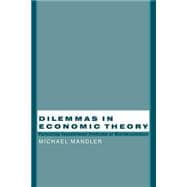
Note: Supplemental materials are not guaranteed with Rental or Used book purchases.
Purchase Benefits
What is included with this book?
| Introduction: The Transformation of Economic Theory | p. 3 |
| Three transitions | p. 4 |
| The timing of the transitions | p. 7 |
| Theory versus practice | p. 8 |
| Where early neoclassical theory fails | p. 10 |
| Interest theory: a further blindspot | p. 11 |
| Why the history of economic theory? | p. 13 |
| Marginal Productivity and the Indeterminacy of Factor Prices | p. 16 |
| Introduction and overview | p. 16 |
| Marginal productivity theory | p. 19 |
| Initial criticisms of marginal productivity theory | p. 20 |
| Nondifferentiable production and indeterminacy | p. 22 |
| Alternatives to differentiable production | p. 23 |
| Fixed-coefficients theory and its critics | p. 25 |
| Long-run theories | p. 30 |
| Factor pricing in contemporary theory | p. 37 |
| Factor-price indeterminacy revisited: Sraffa and general equilibrium theory | p. 46 |
| Conclusion | p. 49 |
| Appendix | p. 50 |
| The Prehistory of Distribution Theory: The Wage Fund and the Invention of Marginal Productivity | p. 52 |
| Overview | p. 52 |
| Factor pricing in classical economics | p. 53 |
| The wage fund | p. 55 |
| J. S. Mill and elastic factor supply | p. 59 |
| Between the wage fund and marginal productivity | p. 61 |
| The emergence of marginal productivity | p. 64 |
| Conclusion | p. 65 |
| The Ordinal Revolution | p. 66 |
| Introduction | p. 66 |
| Demand analysis and neoclassical economics | p. 68 |
| Hedonism and its advantages | p. 72 |
| Early neoclassical accounts of deliberation | p. 76 |
| Ordinal preference theory | p. 78 |
| Ordinalism versus cardinalism | p. 82 |
| Diminishing marginal utility and psychological concavity | p. 85 |
| Should assumptions be placed only on preferences? | p. 87 |
| Convexity versus diminishing marginal utility | p. 93 |
| Transitivity and completeness | p. 96 |
| Conclusions | p. 104 |
| Postscript: choice under uncertainty | p. 107 |
| Historical Issues in Preference Theory: Cardinality and the Transition to Ordinalism | p. 110 |
| Cardinality and cardinal measurability | p. 111 |
| Cardinality based on pleasure | p. 112 |
| The end of hedonism | p. 115 |
| Fisher: non-hedonistic cardinality | p. 117 |
| The move to ordinalism | p. 121 |
| Paretian Welfare Economics | p. 123 |
| Introduction and overview | p. 123 |
| Economic utilitarianism | p. 125 |
| Early neoclassical definitions of efficiency | p. 131 |
| The rejection of utilitarianism | p. 134 |
| Bergson-Samuelson social welfare functions | p. 136 |
| An example: Harsanyi social welfare functions | p. 138 |
| Compensation criteria | p. 140 |
| Hicksian variations: cost-benefit analysis | p. 142 |
| Output comparisons | p. 145 |
| The postwar consensus | p. 150 |
| Problems with Pareto optimality | p. 153 |
| Policy paralysis: a social-choice example | p. 157 |
| Conclusion | p. 162 |
| A Positive Rate of Interest? | p. 164 |
| Introduction | p. 164 |
| The classical position | p. 167 |
| Early neoclassical interest rate theory | p. 170 |
| Contemporary interest rate theory and the impatience assumption | p. 175 |
| Technological arguments for a positive interest rate | p. 180 |
| Land and interest | p. 187 |
| Conclusion | p. 188 |
| Appendix | p. 189 |
| Conclusion | p. 191 |
| Anomaly versus norm in theoretical models | p. 191 |
| Form and content | p. 192 |
| References | p. 193 |
| Index | p. 203 |
| Table of Contents provided by Syndetics. All Rights Reserved. |
The New copy of this book will include any supplemental materials advertised. Please check the title of the book to determine if it should include any access cards, study guides, lab manuals, CDs, etc.
The Used, Rental and eBook copies of this book are not guaranteed to include any supplemental materials. Typically, only the book itself is included. This is true even if the title states it includes any access cards, study guides, lab manuals, CDs, etc.